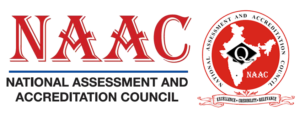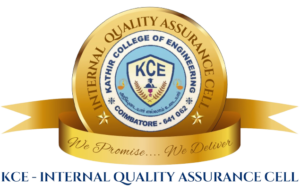

Internal Quality Assurance Cell (IQAC)
About IQAC Cell
In pursuance of its Action Plan for performance evaluation, assessment & accreditation & quality up-gradation of institutions of higher education, NAAC proposes that every accredited institution should establish an Internal Quality Assurance Cell (IQAC) as a post-accreditation quality sustenance measure. Since quality enhancement is a continuous process, the IQAC will become a part of the institution’s system & work towards the realization of the goals of quality enhancement & sustenance. The prime task of the IQAC is to develop a system for conscious, consistent & catalytic improvement in the overall performance of institutions.
STRATEGIES OF IQAC at KCE
- Ensuring timely, efficient, and progressive performance of academic, administrative, and financial tasks
- The relevance and quality of academic and research programs
- Equitable access to and affordability of academic programs for various sections of society
- Optimization and integration of modern methods of teaching and learning
- The credibility of evaluation procedures
- Ensuring the adequacy, maintenance, and functioning of the support structure and services
- Research sharing and networking with other institutions in India and abroad
FUNCTIONS of IQAC at KCE
- Development and application of quality benchmarks/parameters for various academic and administrative activities of the institution
- Facilitating the creation of a learner-centric environment conducive to quality education and faculty maturation to adopt the required knowledge and technology for participatory teaching and learning process
- Arrangement for feedback response from students, parents, and other stakeholders on quality-related institutional processes
- Dissemination of information on various quality parameters of higher education
- Organization of inter and intra institutional workshops, seminars on quality related themes, and promotion of quality circles
- Documentation of the various programs/activities leading to quality improvement
- Acting as a nodal agency of the Institution for coordinating quality-related activities, including adoption and dissemination of best practices
- Development and maintenance of institutional database through MIS for the purpose of maintaining/enhancing the institutional quality
- Development of Quality Culture in the institution
- Preparation of the Annual Quality Assurance Report (AQAR) as per guidelines and parameters of NAAC, to be submitted to NAAC
Mission
- To evolve a regardful, agreeing and stimulant quality improvement system that inspirit the work of the staff and students of the college.
- To advance inventive exercises to continually improve the benefit of the teaching-learning experiences of the staff and students.
- To assure a learner-focused surrounding equipped with the latest methodologies and technologies of teaching, research and sharing knowledge
IQAC Committee Composition
- Composition of committee members for the Year 2022-2023
- Composition of committee members for the Year 2021-2022
- Composition of committee members for the Year 2020-2021
- Composition of committee members for the Year 2019-2020
- Composition of committee members for the Year 2018-2019
- Composition of committee members for the Year 2017-2018
- Composition of committee members for the Year 2016-2017
AQAR
Minutes of Meeting
05.08.2022-View/Download
19.08.2021 –View/Download
27.01.2022 – View/Download
02.09.2020 –View/Download
28.01.2021 –View/Download
12.09.2019 –View/Download
17.02.2020 –View/Download
14.09.2018 –View/Download
20.02.2019 –View/Download
07.07.2017 –View/Download
11.01.2018 – View/Download
02.02.2017 –View/Download
15.09.2016 –View/Download
NAAC Document – View Document
Criteria (1-7) – View Document
DVV
| Extended ID | Deviation Details | Clarification |
|---|---|---|
| 1.1 | Number of courses offered by the Institution across all programs during the last five years. | |
| 1.2 | Number of programs offered year-wise for last five years | 1.2 |
| 2.1 | Number of students year-wise during last five years | 2.1 |
| 2.3 | Number of outgoing / final year students year-wise during last five years | 2.3 |
| 3.1 | Number of full time teachers year-wise during the last five years | 3.1 |
| 4.1 | Total number of classrooms and seminar halls | 4.1 |
| 4.2 | Total Expenditure excluding salary year-wise during last five years ( INR in Lakhs) | 4.2 |
| 4.3 | Number of Computers | 4.3 |
| Metric ID | Deviation Details | Clarification |
|---|---|---|
| 1.2.1 | Percentage of Programmes in which Choice Based Credit System (CBCS)/Elective course System has been implemented | 1.2.1 |
| 1.2.2 | Number of Add on/Certificate Programs offered during the last five years 1. 2019-2020 2. 2018-2019 3. 2017-2018 4.2016-2017 | 1.2.2 |
| 1.2.3 | Number of Add on /Certificate programs offered during the last four years
| 1.2.3(1) 1.2.3(2) 1.2.3(3) 1.2.3(4) |
| 1.3.3 | Percentage of students undertaking project work/field work/ internships (Data for the latest completed academic year | 1.3.3 |
| 2.1.2 | Average percentage of seats filled against reserved categories (SC, ST, OBC, Divyangjan, etc. as per applicable reservation policy ) during the last five years ( exclusive of supernumerary seats) | 2.1.2 |
| 2.4.1 | Average percentage of full time teachers against sanctioned posts during the last five years | 2.4.1 |
| 2.4.2 | Average percentage of full time teachers with Ph. D. / D.M. / M.Ch. / D.N.B Superspeciality /D.Sc. / D.Litt. during the last five years (consider only highest degree for count) | 2.4.2 |
| 3.2.2 | Number of workshops/seminars conducted on Research Methodology, Intellectual Property Rights (IPR) and entrepreneurship during the last five years | 3.2.2 |
| 3.4.4 | Average percentage of students participating in extension activities at 3.4.3. above during last five years | 3.4.4 |
| 4.1.4 | Average percentage of expenditure, excluding salary for infrastructure augmentation during last five years(INR in Lakhs) | 4.1.4 |
| 4.3.2 | Student – Computer ratio (Data for the latest completed academic year) | 4.3.2 |
| 4.4.1 | Average percentage of expenditure incurred on maintenance of infrastructure (physical and academic support facilities) excluding salary component during the last five years(INR in Lakhs) | 4.4.1 |
| 5.1.1 | Average percentage of students benefited by scholarships and freeships provided by the Government during last five years | 5.1.1 |
| 5.1.2 | Average percentage of students benefitted by scholarships, freeships etc. provided by the institution / non- government agencies during the last five years | 5.1.2 |
| 5.1.3 | Capacity building and skills enhancement initiatives taken by the institution include the following 1. Soft skills 2. Language and communication skills 3. Life skills (Yoga, physical fitness, health and hygiene) 4. ICT/computing skills | 5.1.3 |
| 5.1.4 | Average percentage of students benefitted by guidance for competitive examinations and career counselling offered by the Institution during the last five years | 5.1.4 |
| 5.2.1 | Average percentage of placement of outgoing students during the last five years | 5.2.1 |
| 5.2.3 | Average percentage of students qualifying in state/national/ international level examinations during the last five years (eg: IIT-JAM/CLAT/ NET/SLET/GATE/ GMAT/CAT/GRE/ TOEFL/ Civil Services/State government examinations, etc.) | 5.2.3 |
| 6.3.2 | Average percentage of teachers provided with financial support to attend conferences/workshops and towards membership fee of professional bodies during the last five years | 6.3.2 |
| 6.4.2 | Funds / Grants received from non-government bodies, individuals, philanthropers during the last five years (not covered in Criterion III) | 6.4.2 |
| 7.1.4 | Water conservation facilities available in the Institution: 4. Waste water recycling |
